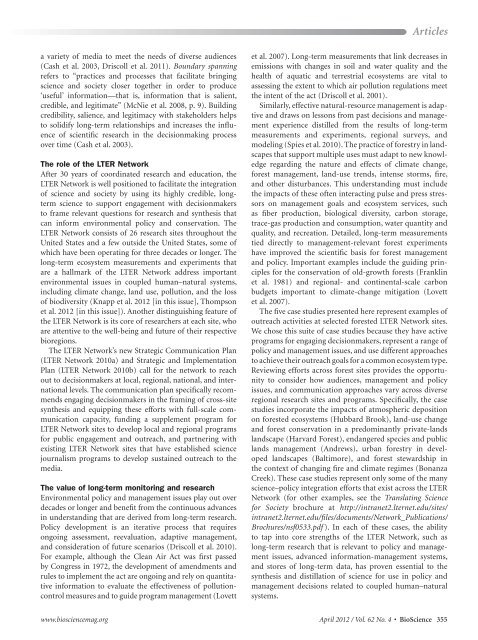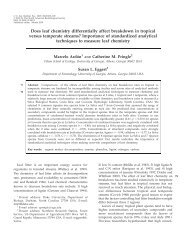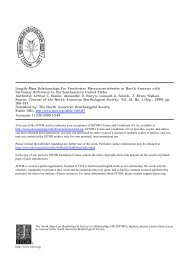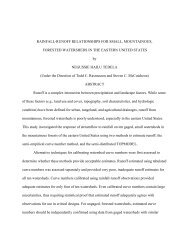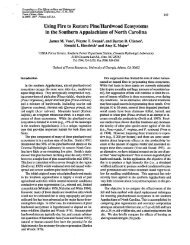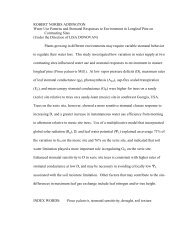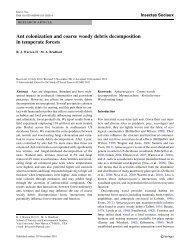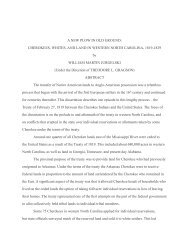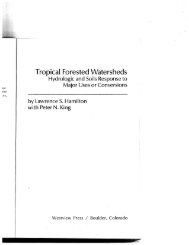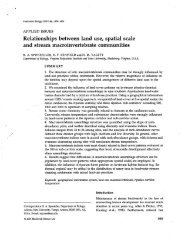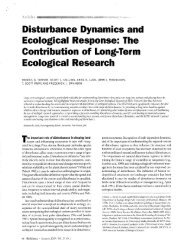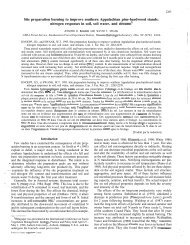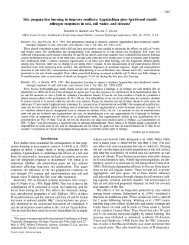biology join - Coweeta LTER - University of Georgia
biology join - Coweeta LTER - University of Georgia
biology join - Coweeta LTER - University of Georgia
Create successful ePaper yourself
Turn your PDF publications into a flip-book with our unique Google optimized e-Paper software.
a variety <strong>of</strong> media to meet the needs <strong>of</strong> diverse audiences<br />
(Cash et al. 2003, Driscoll et al. 2011). Boundary spanning<br />
refers to “practices and processes that facilitate bringing<br />
science and society closer together in order to produce<br />
‘useful’ information—that is, information that is salient,<br />
credible, and legitimate” (McNie et al. 2008, p. 9). Building<br />
credibility, salience, and legitimacy with stakeholders helps<br />
to solidify long-term relationships and increases the influence<br />
<strong>of</strong> scientific research in the decisionmaking process<br />
over time (Cash et al. 2003).<br />
The role <strong>of</strong> the <strong>LTER</strong> Network<br />
After 30 years <strong>of</strong> coordinated research and education, the<br />
<strong>LTER</strong> Network is well positioned to facilitate the integration<br />
<strong>of</strong> science and society by using its highly credible, longterm<br />
science to support engagement with decisionmakers<br />
to frame relevant questions for research and synthesis that<br />
can inform environmental policy and conservation. The<br />
<strong>LTER</strong> Network consists <strong>of</strong> 26 research sites throughout the<br />
United States and a few outside the United States, some <strong>of</strong><br />
which have been operating for three decades or longer. The<br />
long-term ecosystem measurements and experiments that<br />
are a hallmark <strong>of</strong> the <strong>LTER</strong> Network address important<br />
environmental issues in coupled human–natural systems,<br />
including climate change, land use, pollution, and the loss<br />
<strong>of</strong> biodiversity (Knapp et al. 2012 [in this issue], Thompson<br />
et al. 2012 [in this issue]). Another distinguishing feature <strong>of</strong><br />
the <strong>LTER</strong> Network is its core <strong>of</strong> researchers at each site, who<br />
are attentive to the well-being and future <strong>of</strong> their respective<br />
bioregions.<br />
The <strong>LTER</strong> Network’s new Strategic Communication Plan<br />
(<strong>LTER</strong> Network 2010a) and Strategic and Implementation<br />
Plan (<strong>LTER</strong> Network 2010b) call for the network to reach<br />
out to decisionmakers at local, regional, national, and international<br />
levels. The communication plan specifically recommends<br />
engaging decisionmakers in the framing <strong>of</strong> cross-site<br />
synthesis and equipping these efforts with full-scale communication<br />
capacity, funding a supplement program for<br />
<strong>LTER</strong> Network sites to develop local and regional programs<br />
for public engagement and outreach, and partnering with<br />
existing <strong>LTER</strong> Network sites that have established science<br />
journalism programs to develop sustained outreach to the<br />
media.<br />
The value <strong>of</strong> long-term monitoring and research<br />
Environmental policy and management issues play out over<br />
decades or longer and benefit from the continuous advances<br />
in understanding that are derived from long-term research.<br />
Policy development is an iterative process that requires<br />
ongoing assessment, reevaluation, adaptive management,<br />
and consideration <strong>of</strong> future scenarios (Driscoll et al. 2010).<br />
For example, although the Clean Air Act was first passed<br />
by Congress in 1972, the development <strong>of</strong> amendments and<br />
rules to implement the act are ongoing and rely on quantitative<br />
information to evaluate the effectiveness <strong>of</strong> pollution-<br />
control measures and to guide program management (Lovett<br />
Articles<br />
et al. 2007). Long-term measurements that link decreases in<br />
emissions with changes in soil and water quality and the<br />
health <strong>of</strong> aquatic and terrestrial ecosystems are vital to<br />
assessing the extent to which air pollution regulations meet<br />
the intent <strong>of</strong> the act (Driscoll et al. 2001).<br />
Similarly, effective natural-resource management is adaptive<br />
and draws on lessons from past decisions and management<br />
experience distilled from the results <strong>of</strong> long-term<br />
measurements and experiments, regional surveys, and<br />
modeling (Spies et al. 2010). The practice <strong>of</strong> forestry in landscapes<br />
that support multiple uses must adapt to new knowledge<br />
regarding the nature and effects <strong>of</strong> climate change,<br />
forest management, land-use trends, intense storms, fire,<br />
and other disturbances. This understanding must include<br />
the impacts <strong>of</strong> these <strong>of</strong>ten interacting pulse and press stressors<br />
on management goals and ecosystem services, such<br />
as fiber production, biological diversity, carbon storage,<br />
trace-gas production and consumption, water quantity and<br />
quality, and recreation. Detailed, long-term measurements<br />
tied directly to management-relevant forest experiments<br />
have improved the scientific basis for forest management<br />
and policy. Important examples include the guiding principles<br />
for the conservation <strong>of</strong> old-growth forests (Franklin<br />
et al. 1981) and regional- and continental-scale carbon<br />
budgets important to climate-change mitigation (Lovett<br />
et al. 2007).<br />
The five case studies presented here represent examples <strong>of</strong><br />
outreach activities at selected forested <strong>LTER</strong> Network sites.<br />
We chose this suite <strong>of</strong> case studies because they have active<br />
programs for engaging decisionmakers, represent a range <strong>of</strong><br />
policy and management issues, and use different approaches<br />
to achieve their outreach goals for a common ecosystem type.<br />
Reviewing efforts across forest sites provides the opportunity<br />
to consider how audiences, management and policy<br />
issues, and communication approaches vary across diverse<br />
regional research sites and programs. Specifically, the case<br />
studies incorporate the impacts <strong>of</strong> atmospheric deposition<br />
on forested ecosystems (Hubbard Brook), land-use change<br />
and forest conservation in a predominantly private-lands<br />
landscape (Harvard Forest), endangered species and public<br />
lands management (Andrews), urban forestry in developed<br />
landscapes (Baltimore), and forest stewardship in<br />
the context <strong>of</strong> changing fire and climate regimes (Bonanza<br />
Creek). These case studies represent only some <strong>of</strong> the many<br />
science–policy integration efforts that exist across the <strong>LTER</strong><br />
Network (for other examples, see the Translating Science<br />
for Society brochure at http://intranet2.lternet.edu/sites/<br />
intranet2.l ternet.edu/files/documents/Network_Publications/<br />
Brochures/nsf0533.pdf ). In each <strong>of</strong> these cases, the ability<br />
to tap into core strengths <strong>of</strong> the <strong>LTER</strong> Network, such as<br />
long-term research that is relevant to policy and management<br />
issues, advanced information-management systems,<br />
and stores <strong>of</strong> long-term data, has proven essential to the<br />
synthesis and distillation <strong>of</strong> science for use in policy and<br />
management decisions related to coupled human–natural<br />
systems.<br />
www.biosciencemag.org April 2012 / Vol. 62 No. 4 • BioScience 355


